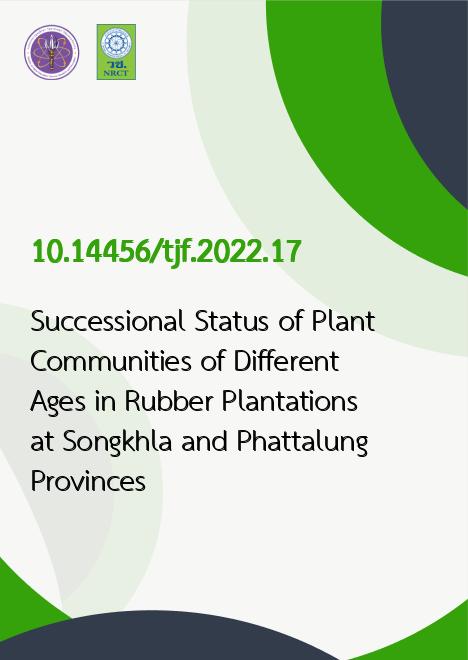
|
Successional Status of Plant Communities of Different Ages in Rubber Plantations at Songkhla and Phattalung Provinces |
|---|---|
| รหัสดีโอไอ | |
| Creator | Sara Bumrungsri |
| Title | Successional Status of Plant Communities of Different Ages in Rubber Plantations at Songkhla and Phattalung Provinces |
| Contributor | Charan Leeratiwong |
| Publisher | Kasetsart University |
| Publication Year | 2565 |
| Journal Title | Thai Journal of Forestry |
| Journal Vol. | 41 |
| Journal No. | 1 |
| Page no. | 48-62 |
| Keyword | Succession, Rubber plantation, Agroforestry, Plant community, Species diversity |
| URL Website | https://li01.tci-thaijo.org/index.php/tjf/article/view/251835 |
| Website title | Thai Journal of Forestry |
| ISSN | 2730-2180 |
| Abstract | Almost all para rubber plantations in Thailand are under monoculture practice, with only a few rubber farmers interested to adopt rubber-based agroforestry practices. Information of native trees which can grow well in a rubber plantation is limited. This research aimed to study the successional status of different-aged plant communities in para rubber plantations. Ten to 77 plots of 10m x 10m size of each were used as sample plots at each study site. In each plot, the diameter at breast height of all trees with a stem diameter of at least 1cm were measured at three locations: (1) near Payang restaurant (successional time 10-12 years), (2) Tamod district (22 year old), and plant conservation area (40 year old). Importance value index (IVI) of the existing species and species diversity index was calculated. Plant community structure varied between the sampled sites. Species with high IVI values varied with each site, site 1; Microcos tomentosa, Cleistanthus polyphyllus, and Mesua kunstleri, site 2; Garcinia merguensis, Decaspermum parviflorum, and Syzygium grande, sites 3; Mesua kunstleri, Microcos tomentosa, and Syzygium lineatum. Litsea grandis, Calophyllum calaba, and Cinnamomum iners were found on all sites. Similarity in plant communities increased with age with the older successional stands being very similar. The diversity index was influenced by distance from natural forest and age of succession. Relative densities of zoochory plants at these sites varied in a range of 50-85% in each plant community. We recommend that certain successional tree species with high IVI and species diversity index in the Tamod district can be planted in rubber plantations with poor soil conditions and low pH. |